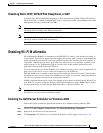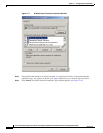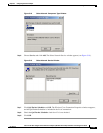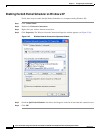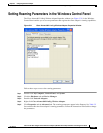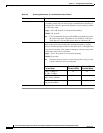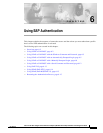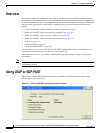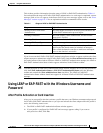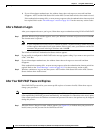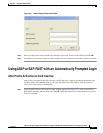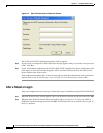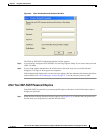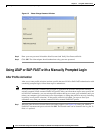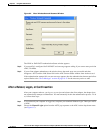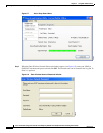
6-3
Cisco Aironet 802.11a/b/g Wireless LAN Client Adapters (CB21AG and PI21AG) Installation and Configuration Guide
OL-4211-03
Chapter 6 Using EAP Authentication
Using LEAP or EAP-FAST with the Windows Username and Password
This window provides information about the status of LEAP or EAP-FAST authentication. Table 6-1
lists and explains the stages of LEAP or EAP-FAST authentication. As each stage is completed, a status
message (such as Success) appears in the Status field. If any error messages appear, refer to the “Error
Messages” section on page 10-12 for an explanation and the recommended action to take.
If you do not want the LEAP or EAP-FAST Authentication Status window to appear each time the client
adapter attempts to authenticate using LEAP or EAP-FAST, check the Show minimized next time check
box at the bottom of the window. On future LEAP or EAP-FAST authentication attempts, the LEAP or
EAP-FAST Authentication Status window appears minimized in the Windows taskbar.
Note To make the LEAP or EAP-FAST Authentication Status window reappear once it has been minimized,
click the LEAP Authentication Status or EAP-FAST Authentication Status tab in the Windows
taskbar and uncheck the Show minimized next time check box. The LEAP or EAP-FAST
Authentication Status window should now appear for all future LEAP or EAP-FAST authentication
attempts.
Using LEAP or EAP-FAST with the Windows Username and
Password
After Profile Activation or Card Insertion
After you (or auto profile selection) activate a profile that uses your Windows username and password
for LEAP or EAP-FAST authentication or you eject and reinsert the client adapter while this profile is
active, the following events occur:
1. The LEAP or EAP-FAST Authentication Status window appears.
2. If your profile is configured for EAP-FAST and a message appears asking if you want to
auto-provision a PAC, click Yes.
Table 6-1 Stages of LEAP or EAP-FAST Authentication
Stage Explanation
Starting LEAP or EAP-FAST
Authentication
The client adapter associates to an access point, and the LEAP
or EAP-FAST authentication process begins.
Checking Link Status The client adapter is EAP authenticated, and the network
connection is verified.
Renewing IP Address If DHCP is enabled, the IP address is released and renewed.
Detecting IPX Frame Type The IPX frame type is reset if AutoDetect is enabled.
Finding Domain Controller If you are logging into a domain and the active profile
specifies that the domain name be included, an attempt is
made to find the domain controller to make sure subsequent
access to the domain is successful.



